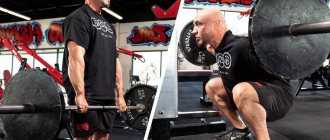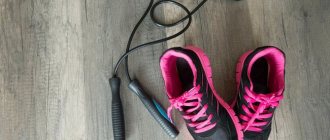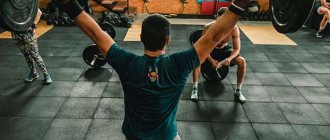5x5 program: the simplest workout to get stronger, build muscle and burn fat
03/26/2017 Training
The 5x5 workout program is the easiest and most effective way to get stronger, build muscle, and burn fat. Thousands of people have used it to transform their bodies. It is very simple and involves only 3 workouts per week, each lasting 45 minutes.
The 5x5 program includes 5 basic exercises: squats, bench press, deadlift, military press and bent-over row. You do 3 exercises in each workout, 3 times a week for 45 minutes. Squats are performed every workout.
The 5x5 program involves performing 5 sets of 5 reps on all exercises except the deadlift, which requires 1 set of 5 reps. Squats will help improve your deadlift performance because they work many of the same muscles.
Unlike most other bodybuilding programs, you don't have to reach muscle failure, pumping, or muscle soreness. Your goal is to increase your working weight. How? Start with light weights, focus on proper form, and add 5 pounds each workout for as long as you can. This is the easiest way to get quick results.
Brief description of the 5x5 program
The 5x5 program consists of two complex workouts:
- Workout A: Squats, bench press, bent-over rows
- Workout B: Squats, military press, deadlift
You train three times a week, alternating between workouts A and B, resting at least 1 day in between. Never train 2 days in a row as the body needs rest to get stronger.
Most people train on Monday, Wednesday and Friday. But you can do it on Tuesday, Thursday and Saturday or on Sunday, Tuesday and Thursday. If you work out 3 times a week and rest at least 1 day between 2 workouts, you will build strength.
When starting the 5x5 program, you will start with workout A, and after 2 days do workout B. So, in the first week you train according to the A/B/A scheme, in the second – B/A/B, in the third – A/B /A and so on.
The graph looks like this:
Week 1
| Monday | Wednesday | Friday |
| Squats 5x5 | Squats 5x5 | Squats 5x5 |
| Bench press 5x5 | Army press 5x5 | Bench press 5x5 |
| Bent-over barbell row 5x5 | Deadlift 1x5 | Bent-over barbell row 5x5 |
Week 2
| Monday | Wednesday | Friday |
| Squats 5x5 | Squats 5x5 | Squats 5x5 |
| Army press 5x5 | Bench press 5x5 | Army press 5x5 |
| Deadlift 1x5 | Bent-over barbell row 5x5 | Deadlift 1x5 |
Further, these programs are simply alternated. Everything is very simple.
All repetitions in all sets are performed with the same weight, not counting light warm-up sets.
Your goal is not to achieve a pump or muscle soreness (although this is possible after lifting heavy weights), but to increase the weight each workout. If you perform 5 reps on each set of an exercise, add 5 pounds to the bar next time. For 1x5 deadlifts, add 5kg each time.
Don't start lifting weights that are too heavy right away, or you'll experience pain that could cause you to skip a workout. Start with light weights so your body can adapt to the stress. Remember to add 2.5 kg per workout (30 kg per month) in squats.
If you're doing free weight exercises like squats, bench presses, and deadlifts without breaking form, start with a load equal to 50% of your 5RM. If you have never worked with free weights, haven’t trained for several years, or don’t know what 5RM is, then start with the following loads:
- Squats, bench press, military press: 20kg (empty Olympic bar).
- Deadlift: 40kg (empty Olympic bar + 2 10kg plates)
- Bent-over barbell row: 30kg (empty Olympic bar + 2 5kg plates)
You'll start with heavier weights on your deadlifts and bent-over rows because it's impossible to perform these exercises correctly with an empty bar. With each new repetition, the barbell should touch the floor.
Your first 2 weeks of training in the 5x5 program will look like this:
Week 1
| Monday | Wednesday | Friday |
| Squats 5x5 – 20 kg | Squats 5x5 – 22.5 kg | Squats 5x5 – 25 kg |
| Bench press 5x5 –20 kg | Military press 5x5 – 20 kg | Bench press 5x5 – 22.5 kg |
| Bent-over barbell row 5x5 – 30 kg | Deadlift 1x5 – 40 kg | Bent-over barbell row 5x5 – 32.5 kg |
Week 2
| Monday | Wednesday | Friday |
| Squats 5x5 – 27.5 kg | Squats 5x5 – 30 kg | Squats 5x5 – 32.5 kg |
| Military press 5x5 – 22.5 kg | Bench press 5x5 – 25 kg | Military press 5x5 – 25 kg |
| Deadlift 1x5 – 45 kg | Bent-over barbell row 5x5 – 35 kg | Deadlift 1x5 – 50 kg |
The deadlift uses more muscles than other exercises, so it will take you less time to progress. As soon as you reach 100 kg in working weight, add 2.5 kg to the bar with each workout.
If these weights seem light to you, remember that you will be adding 2.5 kg each workout. This means you will be squatting 50kg in 4 weeks, 80kg in 4 weeks and 100kg in 12 weeks! And all this in 5 sets of 5 repetitions! This weight is much more than most guys use in the gym. Overall, don't forget what's ahead of you.
You won't always gain weight. After a while, it will become difficult for you to complete 5 repetitions. You may not be able to follow the 5x5 protocol. Don't stop - just try again the next time you train. If this doesn't work, don't worry because there are many ways to overcome the plateau. The important thing now is that you just get started!
Difficulties and errors
Having learned how to do a deadlift, you need to consider the following points:
· due to poor stretching, the technique of any exercise variant suffers. First, it is recommended to stretch the lumbar area, calves and joints of the lower extremities;
· It is undesirable to quickly increase the load, this leads to pain and serious injuries. It is better to slowly increase weight, strictly following technological techniques;
· using different grips often injures the upper limbs and causes curvature of the spine. If the barbell is difficult to hold, use straps
· the optimal training regimen with a significant load is 1 deadlift per week. The athlete's body will need time to recover;
· Exercises are done smoothly, without haste or jerking. The weight is lifted as you inhale and lowered as you exhale;
· rounding of the lower back often leads to spinal injury;
· a traumatic situation arises when a sports equipment is bounced off the floor.
History of the 5x5 program
The basics of the 5x5 program were compiled by Arnold Schwarzenegger's mentor Reg Park in 1960.
Many people have written about it over the past 60 years, so I didn't invent anything new.
I came across the 5x5 program in 2003. Then I trained up to 6 times a week, spending 2 hours in the gym, reaching muscle failure in each set and experiencing muscle pain every day. Unfortunately, I did not know any other training approaches.
Over time, I realized that I have large but weak muscles. After a long search for a solution to the problem, I discovered that to develop strength you need:
- Use free weights, not machines.
- Perform multi-joint exercises that do not isolate.
- Increase working weights without achieving pumping and without causing muscle pain
Everything became clear to me. I started looking for a program that would make me stronger. On one forum, a guy recommended the good old “5x5” to me.
I tried it, and I was very pleased with the results. Since then, the program has become the basis for my training.
Where to begin?
The best way to find out if the 5x5 program will make you stronger is to try it for 12 weeks. Start with the following steps:
- Watch this video and you will see that the program is so simple that anyone can follow it.
- Use my charts - it will motivate you and let you see how much stronger you will be in 12 weeks.
- Choose a gym - all you need is a power rack, a bench, a bar and weight plates.
- Install the “5x5” application - it will show you which exercises to perform and with what weight, as well as how long to rest between approaches. It is free and suitable for iPhone and Android OS.
- Take advantage of my daily tips - many guys read my daily motivational letters first thing in the morning. They claim that this helps them stay on track and continue going to the gym. You can find my tips here.
Apply the acquired knowledge in practice. Only through action will you become stronger.
Goals
Strength development
In ancient Greece, the wrestler Milo of Croton, preparing for the Olympic Games, developed strength by carrying a newborn calf on his back every day. As the animal grew, it became heavier. This training stimulated the athlete’s body to increase strength and muscle mass. He turned Milo into the most powerful fighter of his time.
Perhaps this is just a legend, but practice shows that the 5x5 program helps you become stronger without muscle failure and pumping. You start with light weights, master the technique of doing the exercises and constantly increase the load. Do this for as long as you can and you will get stronger.
The 5x5 program will build real strength, what some call “functional” strength. You just need to adhere to the following basic provisions:
- Free weights. Machines balance the weight for you, which leaves your stabilizing muscles weak. With free weights the opposite is true. They develop real strength, which is why we only use them in the 5x5 program.
- Basic exercises . In everyday life, we rarely do movements similar to bicep curls. Carrying or lifting heavy objects always involves several muscle groups. Therefore, to get stronger, you must do exercises that mimic human movements - deadlifts, squats, etc.
- Barbell _ Squatting with a 180kg barbell on your back is easier than squatting with 90kg dumbbells in each hand. It's also much easier to add 2.5kg per workout when using a barbell than with dumbbells. The 5x5 program involves using a forestay bar because it allows you to lift more weight and progress more easily.
- 5 reps . You can lift more weight at 5 reps than at 8, 10, or 12. The more reps you do, the more fatigued you will become and the worse your form will become. The 5x5 program involves working only 5 repetitions.
- Frequency . The more often you do the exercise, the better your technique becomes and the more effective your workout. When following the 5x5 program, you will do each exercise several times a week, as this is the key to building strength.
Remember that building strength is a marathon, not a sprint. Don't start lifting heavy weights right away in hopes of speeding up results. By doing this, you will only get muscle pain, the desire to skip training, and an early plateau. Start with light weights, build up with each workout, and then you can get stronger at a sustainable pace.
If you can squat 140kg with your hips below parallel to the floor, you are too strong for the 5x5 program. You need a more advanced technique. But if you are not able to squat 100kg without breaking technique, then the 5x5 program is the easiest way for you to quickly increase strength.
Building muscle mass
To build muscle, you don't have to do 10 exercises every workout, work your muscles from different angles, and reach muscle failure or muscle pain.
Instead, you just need to get stronger. Because the stronger you are, the more weight you can lift and the more muscle you can build. Therefore, the athlete who benches 140 kg has larger pectoral muscles than the one who barely benches 60 kg.
This also explains the fact that most successful bodybuilders from Reg Park to Arnold Schwarzenegger and Ronnie Coleman deadlifted over 300 kg.
Many guys think they can't build muscle with the 5x5 program because it only includes 3 exercises. However, the key to building muscle lies not in the amount of exercise, but in the intensity.
Exercises such as squats and deadlifts are called compound exercises because they work multiple muscle groups at the same time.
Let's look at how the 5x5 program will work every muscle in your body.
- Press . The abdominal muscles help maintain balance in exercises such as squats, deadlifts and military presses.
- Shoulders . The shoulder muscles are actively involved in the military press and bench press.
- Breast . By lifting 100kg on a bench press, you can pump up massive pectoral muscles.
- Hands . The biceps are involved in performing bent-over barbell rows, bench presses, and military presses. In addition, in all exercises you grip the barbell tightly, so the arm muscles are almost always involved.
- Forearms . Again, because you're gripping the bar tightly in all exercises, you're promoting forearm muscle growth.
- Trapezoid . The trapezius muscles will become huge by the time you can deadlift 180 kg.
- Hips . Once you can squat 400 pounds, you'll definitely need to buy a new pair of jeans because of your increased thigh muscles.
- Back . Forget about pulling the upper block to the chest! Heavy deadlifts and bent-over rows allow you to build the massive V-shaped back that every athlete dreams of.
- Caviar . The calf muscles are worked by squats and deadlifts.
Weight loss
Weight loss on the 5x5 program depends on the number of calories burned. How can I speed up this process? Increase working weights. If you start squatting with 140 kg on your shoulders, you will turn into a real fat burning machine.
Additionally, you can add half an hour of cardio after your strength training to burn extra calories and speed up weight loss. And don't do cardio on days when your body needs recovery! To lose 500 grams of fat per week, you need to maintain a calorie deficit of 20%.
Fat Burning
Lifting weights builds muscle, burns calories, and increases your metabolism.
Meanwhile, most people try to lose weight by eating fewer calories and not exercising. But few people can stick to low-calorie diets for long periods of time. Ultimately, people tend to relapse, gain more weight, and become fat, weak, and unattractive.
Others try to lose fat with cardio alone. They don't realize that a half-hour cardio workout only burns about 400 calories, which is the equivalent of 1 Big Mac.
In fact, when burning fat, lifting weights should always take priority over cardio for the following reasons:
- Burning calories . The heavier the weight, the higher the intensity and the more calories you burn. Especially if you do compound exercises like squats. This is why strength athletes can eat more than average people and not gain weight.
- Acceleration of metabolism. This phenomenon is called post-workout oxygen consumption. That is, after strength training, the body burns more calories for several hours.
- Muscle building . Cardio and low-calorie diets do not lead to muscle growth the way strength training does. The stronger you become, the more weight you can lift and the more muscle you build.
- Slim physique . Muscle is denser than fat. Lifting weights allows you to build muscle, lose fat, and look slimmer than you previously did at the same body weight.
Mass gain
Some guys (and a lot of women) think that strength training will turn them into bulky athletes like Arnold. However, they do not understand that this requires consuming a lot of food. This means that the 5x5 program alone is not enough to become “unwieldy.”
To gain weight, start with three meals a day. After a month, eat four times a day, and after another month, eat five times a day. Take your time, give your body time to get used to large amounts of food.
And stay away from mass gainers. They are usually full of sugar, which leads to fat deposits and bloating.
Workout Features
The barbell deadlift is considered key for bodybuilders and professional athletes. Before performing it, it is recommended to understand and master the correct technique to prevent injury.
Advantages
Performing barbell deadlifts has many benefits:
· develops many small and large muscle ligaments (about 70% of the total);
· relieves pain in the spine;
· builds power and muscles.
This energy-intensive training has a functional basis. Essentially, it is lifting weights from the ground. Most people encounter this problem in life.
What muscles work?
The deadlift exercise with a barbell produces a load on the following types of muscles:
back;
· belly;
· buttocks and lower extremities;
· hands;
· forearms;
· calf.
Variations of the exercise
The deadlift technique has the following options:
· classic or weightlifting type is carried out with a metal rod;
· dead (Romanian);
· trap bar;
· sumo.
Sports equipment stands on the floor or is located in a power frame.
Exercises
Squats
Squats with a barbell on your shoulders
Squats work the hamstrings, quads, glutes, and calves. The abdominal and lower back muscles are also used as stabilizing muscles.
Squats stimulate the production of testosterone and growth hormone more actively than, for example, leg presses. This is why they are a crucial factor in building strength and muscle mass.
Many people are afraid to do squats because they believe that they will harm their knee joints and cause pain in them. However, the key to safety lies in proper technique. Here are some tips on this matter:
- Move your hips back as if you were sitting in a chair
- Keep your knees outward (don't bring them together) and keep them pointing in the same direction as your toes.
- Lower yourself into a squat until your thighs are parallel to the floor.
Squats to parallel will strengthen your knees rather than harm them.
There are many different types of squats. On the 5x5 program, you will position the bar just below your upper back. This will take the load off your knees and transfer it to your hips.
It's safest to squat in a power rack because if you can't do a rep, you can simply drop the barbell onto the bars.
Bench press
Barbell press lying on a horizontal bench
The bench press works the shoulders, triceps and chest. It uses the abdominal, back and biceps muscles as stabilizing muscles.
Lower the barbell to your chest, then lift it up until your arms are fully extended. Place your elbows at a 45-degree angle to your body. You should go through a full range of motion - this will build more strength and muscle.
This upper body exercise will allow you to lift more weight than the military press.
The 5x5 program does not include incline presses because it is impossible to isolate the upper or lower pecs. The chest muscles contract as a whole.
To avoid injury, perform the press inside a power rack. If you can't complete a repetition, simply drop the barbell onto the limit bars. If the gym doesn't have a power rack, ask someone to hold you down. Also, don't put clamps on the bar so that if you fail, you can tilt the bar to the side and throw off the weight plates.
Deadlift
“There are many programs that can help you improve your deadlift and set personal bests.”
Deadlifts primarily work the hips, glutes, quads, and adductors. It is excellent at stimulating the production of growth hormone and testosterone, so it is crucial for building strength and muscle.
To avoid lower back injuries, always keep your back straight.
Here are some recommendations regarding technique:
- Lift the weight by pushing your heels off the floor (similar to a platform leg press).
- Keep the bar in contact with your feet.
- When the bar reaches knee level, press your hips forward.
- Finish the lift when your legs are fully extended.
- In the upper phase, do not move your torso back.
- Place your feet approximately shoulder width apart
In the 5x5 program, deadlifts are performed for only 1 set of five reps, since doing them 5 sets after squats is very difficult. You'll quickly start missing reps and hit a plateau.
The recommended starting weight if you have never deadlifted before is 40 kg. This means that you will have to use small diameter weight plates, which means the bar will be closer to the floor. Since the bar should be level with your mid-shins when you begin the row, place a pair of weight plates under the bar.
Army press
Military standing barbell press
The military press works the shoulders, triceps, and upper pecs. It also uses the muscles of the legs, back, abdomen and trapezius as stabilizing ones.
As with other exercises, always keep your back straight to avoid injury to your lower back and other parts of your body. Place your feet shoulder-width apart and do not bend.
You can also perform the military press in a power rack. If the height of the ceiling does not allow you to work in full amplitude, then as an alternative you can perform the exercise while sitting. However, in a sitting position, the abdominal muscles will not be used as actively.
Bent-over barbell row
Bent-over barbell row
Bent-over barbell rows work the muscles of the upper back, trapezius, lats and biceps. It uses the muscles of the lower back, abdomen and legs as stabilizing muscles.
To avoid lower back pain, keep your back straight.
The barbell should touch the floor with each repetition, just like with a deadlift. Pull your knees back to make room for the bar to move. The torso can be slightly raised when pulling. If your torso rises more than 15°, this means that you have chosen too heavy a weight.
The recommended starting weight if you have never done a bent-over barbell row before is 30 kg. This means that you will have to use small diameter weight plates, which means the bar will be closer to the floor. Since the apparatus must touch the floor surface with each repetition, place a pair of weight plates.
Benefits for men and women
Why is deadlifting for everyone? Yes, because this is an indispensable exercise for all muscles of the body . The deadlift is one of the most powerful and large-scale exercises in terms of muscles involved. There is only one “but” - in order to get the maximum benefit from this exercise specifically for strength stimulation, the weights must be quite serious for you.
The classic bent-legged deadlift can be performed in different styles - the style determines the position of the pelvis and hips (high or low) in the starting position, and accordingly, the load can increase or decrease on the spinal extensor muscles (especially the lumbar part) and muscles anterior thigh (quadriceps).
Characteristic of any style of deadlift on bent legs (as opposed to deadlift on straight legs) is the initial effort to lift the barbell off the floor due to extension of the legs at the knee and hip joints and subsequent extension of the torso.
The largest release of anabolic hormones is provoked by the classic heaviest exercises - squats and deadlifts, and if you do not do exercises on the upper body, then all their anabolic effect will affect mainly the muscles of the lower body, i.e. muscles subjected to stress.
However, if in addition to squats and deadlifts, you do rows and presses for the upper body, then muscle growth will occur throughout the body. Hence the well-known expression: “to pump up your arms, you must first pump up your legs.”
FAQ
Why is the deadlift only performed in one approach?
Because the deadlift uses more muscles than any other exercise, and
allows you to lift a lot of weight, it takes a lot of strength. It is even more difficult to perform it in 5 approaches after squats.
At first, when the weights are light, you can perform deadlifts in 5 sets. But then you will find it very difficult to cope with such a volume of work, which may lead to a plateau.
How long should you rest between sets?
At the beginning of the program, when the weights are light, you will not need to rest for long. When your weight increases significantly, follow these recommendations:
- 1.5 minutes, if the reps in the last approach were easy
- 3 minutes if the reps in the last approach were difficult
- 5 minutes if you were unable to complete all reps on your last set
Pay attention to your pulse. For example, I often find myself breathing heavily after doing five heavy reps of squats. When my heart rate returns to normal, it usually means I'm ready for the next set.
During the warm-up, do not rest between sets. Simply add weight to the bar and continue with the exercise.
How long should you rest between exercises?
You don't need to rest between exercises. I unload the bar after squats, prepare the machine for the bench press or military press, and then proceed to warm up with an empty bar. By then my central nervous system is recovering.
At what tempo should you perform repetitions?
There are no clear recommendations on this matter. In the first weeks, when the weights are light, simply lift the weights in a controlled manner. Don't go too fast to maintain proper technique, but don't go too slow either.
After the first 12 weeks, as you gain experience and refine your technique, lift the weight as quickly as you can. When lowering the weight, control it and do not throw it.
Rapidly lifting weights is the key to increasing load, and therefore strength.
What should a warm-up look like?
Start with 2 sets of 5 empty bar reps on the squat, bench press, and overhead press. Then add 10-20 kg and do another 2-3 repetitions. Continue adding 10-20 kg, performing 2-3 reps per set until you reach your working weight. Don't rest between these warm-up sets.
This means that in the first weeks of these exercises there will be no warm-up as such, since you will be working with an empty bar. But as soon as you reach 30 kg in working weight, then perform 2 approaches with an empty bar.
It will not be possible to perform deadlifts and bent-over barbell rows with an empty bar, since the apparatus must touch the floor. Plus, by the time you complete them, you will already be warmed up from the previous exercises. Therefore, cargo disks are already used here.
Never perform heavy sets without warming up. This can damage equipment and increase the risk of injury.
How should I breathe when doing exercises?
Don't think about it and you will do everything right. Strength training is not running. Just stay tense. If you lift a heavy projectile from the floor, you automatically take a big breath and hold your breath.
In general, the recommendations look like this:
- Squats . Take a deep breath at the top, hold your breath, perform a squat, and then exhale.
- Bench press . Take a deep breath at the top, perform as many repetitions as possible, exhale at the top when you feel the need. I often do 3 or even 5 repetitions on one breath.
- Deadlift . Take a deep breath in the lower phase, lift the weight, exhale in the upper phase. You can exhale after lowering the weight.
- Army press . Take a deep breath in the lower phase, perform as many repetitions as possible, exhale in the upper or lower phase when you feel the need.
- Bent-over row . Take a deep breath at the bottom, perform as many repetitions as possible, exhale at the bottom when you feel the need.
Can I change the order of the exercises?
No. The order of the exercises is not random and is set in such a way as to achieve the best results.
Is it possible to do workout A and B on the same day?
No. You could do this in the first weeks, when the weights are still light, but later you will not be able to do it.
If you feel like you could do more, just increase the weight. Add 5kg to the bar instead of the usual 2.5kg.
Can you train two days in a row?
No. The body needs rest to recover and build muscle. If you feel like your workouts are easy, just increase the weight.
What should I do if I couldn't complete 5 reps?
Wait 5 minutes for your CNS to recover. Then do the next set with the same weight and aim for 5 reps.
If you missed reps in all 5 sets, then do not increase the weight by 2.5 kg in the next workout, but work with the same thing.
Here are a couple more tips:
- Never do more than 5 reps in 5 sets with the same weight. If you were only able to do 3 reps on the fifth set, there is no need to do the sixth.
- Don't lose weight during your workout. If you did 5 reps on the first set but only 3 on the second, don't reduce the weight, but try your best to complete the prescribed program.
What should I do if I still can't lift the weight for all the reps?
If you cannot follow the 5x5 protocol for three workouts in a row, reduce the weight by 10% for that exercise only. This will give your body extra rest and will also help you avoid a psychological plateau.
How long should you follow the 5x5 program?
As long as you continue to get stronger. 12 weeks is just the beginning. Many guys stuck with the program for 16, 24, and even 52 weeks!
You'll know it's time to move on to a more advanced program when you're unable to add 5 pounds per workout.
Is it possible for a woman to train according to the 5x5 program?
Yes, but some differences may appear:
- An empty bar may be too heavy . My friend, for example, does goblet squats and deadlifts with a kettlebell, and presses with dumbbells.
- Even lighter weight rims will be required . Adding 2.5kg to the bench press and military press each workout may be too much for a woman since she tends to have smaller upper body muscles than a man.
Source: https://stronglifts.com/5×5/
Barbell Squats
Problem: I don’t have the strength to get up from the bottom position.
Solution: Barbell back squats. As you lower, your quads stretch and store energy, like an extended spring. This energy then combines with the powerful contractile force of the quadriceps to help lift you up. If you are unable to get up from the bottom position, your quadriceps are not strong enough. You should pump up “pure” quadriceps strength, excluding the help of an energy impulse.
Execution technique
- Set the support rods at the height of the bottom bar position in the squat. Place the bar on the bars and load with a weight that is 10% less than your 6 rep max.
- Sit under the barbell and take the bottom position. (The bar rests on support rods.)
- Slowly straighten up and then lower down again. In the bottom position, come to a full stop by lowering the barbell onto the support bars. Then do a new repetition.
Scheme: Do 3-4 sets of 6 reps at the very beginning of your leg workout. Then follow the usual steps.











